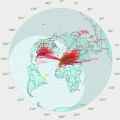rrobinet
I have configured several Kiwis for wifi access by attaching an inexpensive router configured as a Wifi client to the ethernet port of the Kiwi. This $25 TP Link has worked well for me:
https://smile.amazon.com/TP-Link-Wireless-Portable-Travel-Router/dp/B00TQEX8BO/ref=sr_1_14?keywords=tplink+wifi+router&qid=1548188019&sr=8-14
In principle one could enable the internal BB Wifi or attach a USB wifi adapter, but I am reluctant to fiddle with the Kiwi's OS.
About
- Username
- rrobinet
- Joined
- Visits
- 1,325
- Last Active
- Roles
- Member
- Points
- 9
-
wsprdaemon - A Raspberry Pi WSPR decoding service
-
Connecting Kiwi via WiFi
Thanks to all of you on this thread I have been able to change all of my wired LAN connections to Wifi and remove one major source of crud.
I am using the $4.50 Zibo dongle from Amazon: https://smile.amazon.com/gp/product/B00RBBUQLE/ref=ppx_yo_dt_b_search_asin_title?ie=UTF8&psc=1
I upgraded to the latest kernel and installed the driver packages and modified the file to make it come up as wan0.
No compiling was required.
Once you are rid of the LAN crud, if you are at a quiet site you may benefit from a preamp ahead of the Kiwi. I use a DXE Clifton modified to stop it from oscillating and can detect the noise from the black hole at the center of our Milky Way on 17M and above. -
Connecting Kiwi via WiFi
Thanks to all of you on this thread I have been able to change all of my wired LAN connections to Wifi and remove one major source of crud.
I am using the $4.50 Zibo dongle from Amazon: https://smile.amazon.com/gp/product/B00RBBUQLE/ref=ppx_yo_dt_b_search_asin_title?ie=UTF8&psc=1
I upgraded to the latest kernel and installed the driver packages and modified the file to make it come up as wan0.
No compiling was required.
Once you are rid of the LAN crud, if you are at a quiet site you may benefit from a preamp ahead of the Kiwi. I use a DXE Clifton modified to stop it from oscillating and can detect the noise from the black hole at the center of our Milky Way on 17M and above. -
wsprdaemon - A Raspberry Pi WSPR decoding service
I have just enhanced graphs.wsprdaemon.org so that if you configure your wsprdaemon to upload graphs, you can view those graphs at http://graphs.wsprdaemon.org/SIGNAL_LEVEL_UPLOAD_ID/
It can take up to 10 minutes between setting up your configuration and the appearance of that link.
Sites with low noise levels (i.e. < -150 dBm) or 'top spotters' may appear on http://graphs.wsprdaemon.org/ unless you don't want your graphs there. -
wsprdaemon - A Raspberry Pi WSPR decoding service
I have attached WD V2.5a to this post. It includes a large number of installation and run time fixes, most importantly a 'monitor for and kill zombie recording sessions on the Kiwi(s)'.
There is also major new feature: It can be configured to generate graphs of background noise level measurements at the same time as WSPR decodes which can be viewed by the Apache web service running on the WD server.
Those graphs can give you great insights into the quality of your receive system and site. However calculating the noise levels triples the CPU requirements on the server, so a Raspberry Pi which can support 20 no-noise bands can only support 8 bands with the noise feature enabled. So if you have more than one Kiwi and want noise graphs, you should wun WD on an Odroid, Atomic Pi, or x86 server running Ubuntu 18.04.
This code should be completely compatible with existing 2.3 installations, so save your WD2.3, stop your current WD with '-z', copy this code over the existing WD.sh and start it with '-a'
As before, '-s' will print the status of your system.
Because of all the fixes, I recommend that all sites upgrade to this code. Please report your experience and if you have problems you can easily revert to your WD 2.3 code.



